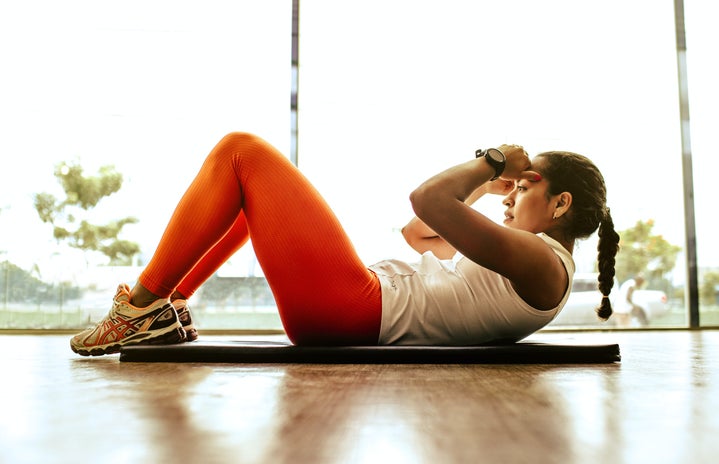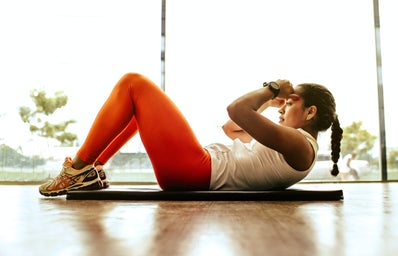Disclaimer: This article is in no way calling for the reader to change their exercise or eating habits. Its goal is to explain common misconceptions about fitness.
Last year, Chloe Ting promised the social media realm “Abs in 2 WEEKS!” The Keto diet convinced many that carbs are the enemy. Fitness influencers continue to pose with fat-burning teas in hopes of purchases from followers.
Every person walks, bikes, runs or strength-trains down a different path on their fitness journey. It is totally acceptable to take part in core strengthening challenges or to try a new diet, but there are misconceptions reinforced by social media that you should be aware of.
Here are five fitness myths that you need to stop believing:
- Crunches will give you abs.
-
Our love-hate relationship with crunches most likely began in elementary school physical education. Lying on a blue mat, a partner sitting on your feet, arms tucked behind your head, awaiting the beep “one” count to sit up and meet your knees, only to return to the mat and repeat as many times as possible.
If crunches could give you abs, the odds are we would probably see a lot more six-packed six-year-olds. Indeed, crunches do not give you abs.
Everyone, yes, everyone, has abdominal muscles, but the reason you don’t see them is due to a layer of body fat covering them. The only way to reveal your abs is to decrease your body fat percentage; however, for some, this number may be extremely difficult, and unhealthy, to maintain. The only way to decrease body fat percentage is to be in a caloric deficit – you burn more calories than you consume.
Having a strong core is important, especially if you are doing any compound lifts like squats, deadlifts or bench press, but there are more effective ways to strengthen your core than repeatedly sitting up.
- Lifting weights will make you bulky.
-
Lifting heavier weights allows you to build muscle while losing fat. You will increase your lean body mass, which will increase the number of calories you burn during the day – even at rest.
In order to bulk up your body or gain weight, you need to eat more. Yet again, diet and calorie consumption play a large role in fitness and physique goals.
Oftentimes when lifting, the numbers on the scale will not change. Keep in mind: muscle weighs more than fat. You are shaping your body by lifting heavier weights, so to keep track of progress rely on photos, body measurements and overall wellbeing rather than the scale.
- Cardio is the best way to lose fat.
-
The only way to lose fat is to be in a caloric deficit. Cardio is great for cardiovascular health, and your heart is a muscle, but strength training is the best way to lose fat. This type of training allows you to lose fat while maintaining and gaining lean muscles that burn calories.
By supplementing the treadmill with a barbell, chances are you will increase your Basal Metabolic Rate (BMR). This is known as your metabolism and is the number of calories required for your body to function while at rest. When you increase this number, you increase your Total Daily Energy Expenditure (TDEE), which is the number of calories you burn on an average day when factoring in BMR, thermic effect of food and activity. A higher TDEE makes a caloric deficit easier to be achieved, and consequently, loss of excess body fat.
- Carbs are bad for you.
-
Gaining weight results from consuming more calories than you are burning. The amount of a macronutrient (such as a carbohydrate) consumed does not matter if you are eating in a caloric surplus.
Carbs serve as the main energy source for the human body, and a necessary macronutrient for muscle building. However, there is a difference between whole and refined carbs, in which whole carbs are more beneficial.
Prioritize whole carbs in your diet including vegetables, potatoes, whole-grain breads and pastas, legumes and quinoa. Continue to enjoy refined carbs like white bread, pastries and other items made with white flour in moderation.
Unprocessed carbohydrates have many health benefits, so there is no need to completely cut them from your diet. Don’t opt for a lettuce bun when a whole grain one will be much more satisfying and filling.
- You can tone a muscle.
-
Oftentimes when you ask someone what their fitness goal is they will respond with “I want to get toned.” You cannot tone a muscle. You cannot spot reduce fat.
To achieve this ‘toned’ look, you need to strength train to build muscle but reduce calories to lower body fat.
Using lighter weights for more reps is not the way to achieve the “muscle tone.” Muscles are fixed by tendons and bones, so doing sets of 2-3 reps versus 8-10 will not result in a different shape. In terms of muscle growth, you can use a lighter weight for several reps if you choose, but heavier weight stimulates muscle growth more.
After you have grown your muscles, in order to see them you would have to reduce your body fat. The key to lowering your body fat percentage is nutrition. Yet again, nutrition plays a major role in one’s desired physique.
To achieve any fitness goals, adequate hydration, sleep, exercise and balanced consumption of macro and micronutrients are required, along with paying attention to your mental health and prioritizing self-care.
Instead of falling into fad diets, focus on nutrition, prioritize protein, consume plenty of fruits and veggies, but also let yourself enjoy the foods you love. Yes, eat that Publix chocolate chip cookie or that glistening slice of pizza — everything in moderation promises sustainable habits.
Whether you want to be the strongest person in the room or take your first steps toward building healthy habits, keep these myths in mind as you grab your weights and eat your carbs without guilt.


